
Sonic x Shadow Generations review – brilliant new campaign leaves the blue blur overshadowed
Shadow’s
campaign
provides
some
of
the
best
3D
levels
of
the
series,
but
it’s
coupled
with
a
dated
and
unnecessary
remaster.
If
only
Sega
went
all-in
on
the
future.
After
years
of
experimenting,
Sega
has
now
established
two
types
of
3D
Sonic
level.
The
first
are
the
open
zones
of
Sonic
Frontiers
that
give
the
hedgehog
the
space
and
freedom
to
unleash
his
speed,
the
sort
of
wide
open
design
only
possible
(just!)
on
modern
hardware.
The
second
are
the
tightly-focused,
mostly
linear
stages
that
evolve
the
side-scrolling
original
games
into
3D
rollercoasters
with
dizzyingly
shifting
perspectives,
a
design
first
popularised
in
the
Sonic
Adventure
games.
It’s
the
latter
style
that
Sega
has
absolutely
nailed
with
the
brand
new
Shadow
campaign
in
Sonic
x
Shadow
Generations.
These
might
just
be
the
best
3D
levels
in
a
Sonic
game
to
date
–
and
the
blue
hedgehog
is
barely
to
be
seen.
Sonic
x
Shadow
Generations
is
predominantly
a
remaster
of
2011’s
Sonic
Generations,
but
now
–
to
celebrate
the
Year
of
Shadow
and
his
appearance
in
the
forthcoming
Sonic
the
Hedgehog
3
film
–
Sega
has
tacked
on
an
all-new
campaign
for
Shadow
the
Hedgehog
that
runs
in
parallel.
It’s
also
releasing
DLC
to
tie
into
the
film,
though
that’s
not
available
until
December.
Just
as
Sonic
was
sucked
into
White
Space
to
relive
his
past
in
both
Classic
and
Modern
guises
in
the
original
release,
so
too
has
Shadow
in
his
own,
entirely
separate,
story.
our
Sonic
x
Shadow
Generations
video
reviewWatch
on
YouTube
That
means
a
rehash
of
plot
points
from
previous
games
(Shadow
the
Hedgehog
and
Sonic
’06
mostly)
as
Shadow
confronts
Black
Doom
and
his
tragic
origin
story.
But
more
so,
it’s
an
excuse
to
revisit
and
enhance
maligned
stages
from
the
past
in
modernised
form.
These
new
levels
are
intense,
breathtaking
thrill
rides
filled
with
set
pieces
and
constant
motion
that
never
lets
up.
One
moment
Shadow
is
riding
rails
through
space
and
punching
missiles,
the
next
he’s
flying
down
waterfalls,
being
chased
by
killer
trains,
and
corkscrewing
through
a
warped
metropolis
of
bending
skyscrapers.
Stages
are,
as
ever,
split
into
two
acts,
with
the
first
being
fully
3D
and
the
second
side-scrolling
(though
there’s
no
Classic
Shadow
model,
unlike
Sonic),
with
the
latter
being
a
vast
improvement
over
last
year’s
Sonic
Superstars
and
its
attempt
to
capture
past
glories.
Yet
beyond
the
spectacle
of
both
acts,
stages
are
crucially
designed
to
maintain
momentum
and
flow,
if
you’ve
got
the
skills
to
pull
it
off
of
course.
Rare
are
moments
where
Shadow
stops
moving;
he’s
always
running,
or
leaping
to
the
next
grind
rail,
or
charging
towards
a
switch
or
enemy.
Enemies
are
also
smartly
placed
to
keep
the
rhythm
going,
rather
than
offbeat
interruptions.
And
while
focused,
levels
are
designed
with
multiple
paths
that
reward
exploration
and
experimentation
with
Shadow’s
new
moveset.


level
are
thrilling
and
dynamic
with
plenty
of
set
pieces
|
Image
credit:
Sega
/
Eurogamer
Those
moves
are
powered
by
bad
guy
Black
Doom
and
are
unlocked
gradually
throughout
the
campaign’s
story,
but
usable
in
previous
levels.
Shadow
gains
the
ability
to
surf
over
water,
fly
through
the
air,
or
shoot
spears
to
stun
enemies.
My
personal
favourite
is
Doom
Blast:
a
dramatic
uppercut
that
not
only
allows
Shadow
to
launch
enemies
but
then
teleport
to
them,
often
opening
new
shortcuts.
These
are
in
addition
to
his
iconic
Chaos
Control
move
to
slow
time,
used
for
both
dodging
enemies
and
forming
pathways
with
moving
obstacles.
Extra
side
challenges
also
provide
an
opportunity
to
practise
with
these
abilities
in
remixed,
standalone
stages,
though
these
quick
hits
can
sometimes
frustrate.
In
all,
the
Doom
Powers
are
mostly
optional,
but
they
add
an
extra
layer
of
complexity
that’s
relevant
to
Shadow’s
character,
raises
the
required
skill
level,
and
boosts
him
beyond
his
blue
nemesis.
More
importantly,
Shadow’s
basic
moveset
is
a
joy
to
handle.
Sega
made
the
smart
decision
to
give
Shadow
a
double
jump
and
move
his
homing
attack
to
a
separate
button.
It
may
seem
like
a
small
change
from
Sonic,
but
it
gives
players
so
much
more
control
over
the
character
and,
coupled
with
a
generous
lock-on,
puts
an
end
to
sloppy
targeting
and
infuriating
confusion
between
jumps
and
attacks.
For
Sonic
fans,
Shadow
is
a
dream
to
handle
–
and
that’s
a
relief
to
be
able
to
write
here,
after
so
many
misfires.
It
just
feels
right.
For
the
first
time
in
a
long
time
I
don’t
feel
like
I’m
fighting
the
controls,
or
on
edge
about
to
glitch
through
the
environment.
It’s
like
Sega’s
ideas
have
at
last
clicked
into
place.
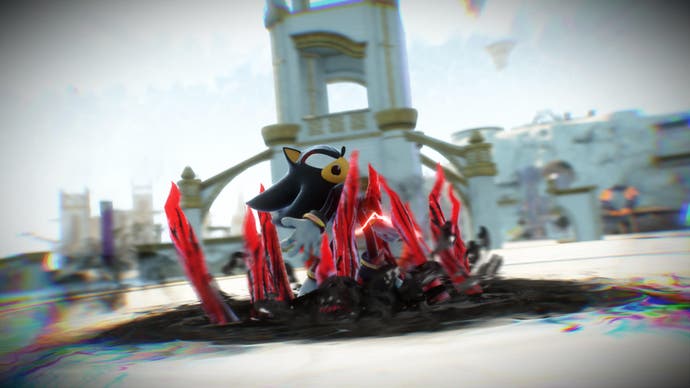
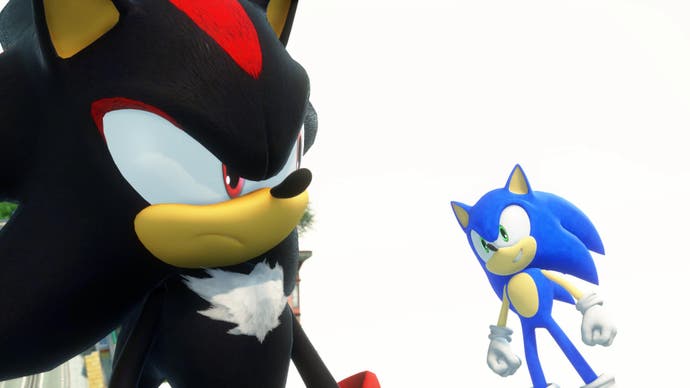

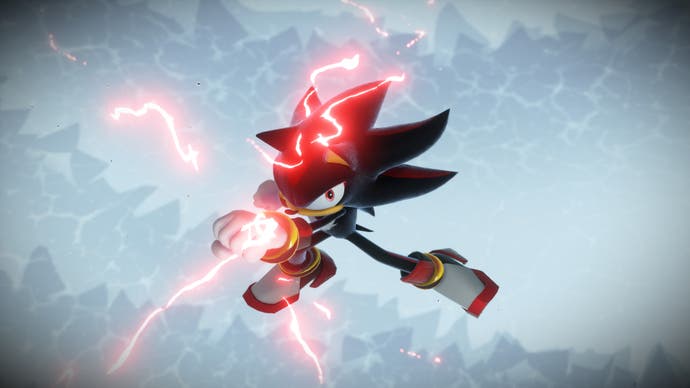
powers
come
with
some
brutal
transformations
|
Image
credit:
Sega
/
Eurogamer
It’s
not
all
linear
levels,
though.
In
a
nod
to
the
Open
Zones
of
Sonic
Frontiers,
Shadow’s
version
of
White
Space
is
a
fully
explorable
hub
world
that’s
slowly
unveiled
as
the
story
progresses.
It
doesn’t
provide
quite
the
same
sensation
of
speed,
but
it
does
add
platforms
and
rails
without
all
the
pop-in.
What’s
more,
it’s
full
of
treasure
chests
unlocked
with
icons
gathered
in
each
level,
which
add
art,
music
and
more
to
the
collection.
Occasionally
reaching
these
chests
and
collectibles
requires
the
sort
of
careful
platforming
the
controls
aren’t
really
attuned
for,
but
it’s
forgivable
when
the
main
stages
are
such
a
marvel.
Where
Sonic
Generations
drew
upon
20
years
of
nostalgia
as
a
celebration
of
the
series
up
to
that
point,
Shadow
doesn’t
have
that
same
luxury,
with
only
a
handful
of
starring
roles
(in
fact,
one
level
is
based
on
Sonic
Frontiers,
in
which
he
doesn’t
appear).
As
such,
his
campaign
is
more
of
a
re-introduction
of
the
character
that’s
tacked
on
to
an
existing
game.
Perhaps,
after
his
previous
failure
as
a
headliner,
Sega
felt
Shadow
just
isn’t
strong
enough
on
his
own
to
carry
an
entire
game.
So
while
Sonic
Team
has
delivered
an
outstanding
addition
with
Shadow,
his
campaign
still
only
exists
alongside
Sonic’s.
He
deserves
more.
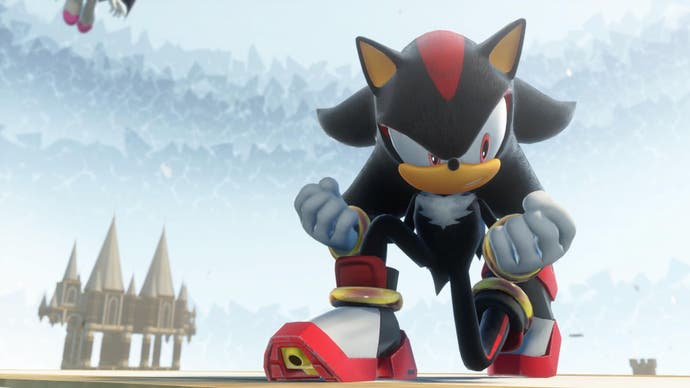
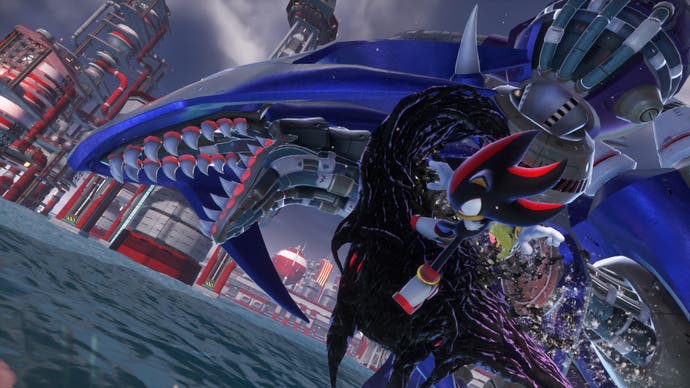
cutscenes
are
incredibly
cool,
especially
when
introducing
bosses
|
Image
credit:
Sega
/
Eurogamer
That’s
where
Sonic
x
Shadow
Generations,
taken
as
a
complete
package,
starts
to
fall
apart.
Side
by
side,
the
two
campaigns
invite
comparison
and
Sonic,
quite
frankly,
cannot
compete.
Where
Sonic
Generations
was
originally
a
culmination
of
previous
games,
now
it’s
simply
an
unfavourable
reminder
of
a
past
I
do
not
wish
to
return
to.
As
a
remaster,
Sega
has
handled
Sonic
Generations
with
a
light
touch.
Visually
it’s
all
been
sharpened
for
modern
standards,
but
textures
and
character
models
lack
detail.
Just
comparing
Shadow’s
boss
model
in
Sonic
Generations
with
his
character
model
in
his
own
campaign,
the
difference
in
quality
is
abundantly
clear.
Cutscenes
in
Sonic
Generations
are
also
stiff
by
comparison,
with
awkward
line
delivery
and
repeated
animations,
where
Shadow’s
scenes
are
dynamic
and
exciting.
Sonic
is
gratingly
chirpy
and
cheerful;
Shadow
is
all
grunts,
grim
looks,
and
action
hero
poses.
He’s
more
fun
to
watch,
more
fun
to
play
as,
and
just…
cooler!
No
wonder
Keanu
Reeves,
of
all
people,
is
voicing
Shadow
in
this
year’s
film.


boss
character
model
in
Sonic
Generations
is
notably
poorer
|
Image
credit:
Sega
/
Eurogamer
Diving
into
the
Sonic
Generations
levels,
meanwhile,
brought
back
all
the
old
frustrations
Shadow
has
lept
beyond.
Aside
from
the
striking
Green
Hill
Zone
and
Chemical
Plant
Zone
recreations,
Sonic’s
levels
fall
into
the
old
traps
of
instant
fails,
bad
targeting,
annoying
enemy
placements,
and
awkward
camera
work.
But
of
course
they
do
–
they’re
old!
I
remember
playing
these
levels
before
and
loving
them,
but
now
they
leave
me
cold.
Where
Shadow’s
levels
I’ve
played
on
repeat
to
relish
the
action,
Sonic’s
levels
I’ve
raced
through
to
get
them
over
with.
The
more
I
played
Sonic’s
half
the
more
I
began
to
question:
is
this
just
not
good
by
comparison,
or
was
it
ever
good
to
begin
with?
It’s
so
dated,
it’s
surprising
Sega
combined
the
two
campaigns
into
such
an
inconsistent
package:
a
reminder
of
an
infuriating
past
next
to
a
future
that
seems
so
sublime,
even
if
purely
by
juxtaposition.
With
this
two-in-one
approach,
Sonic
Team
has
simultaneously
shot
itself
in
the
foot
with
an
unnecessary
look
backwards
and
proven
how
far
it’s
come
in
the
past
13
years.
At
the
very
least,
Sonic
makes
Shadow
look
good.
Yet
even
independently,
Shadow’s
campaign
really
does
deliver
on
the
pure
promise
of
a
Sonic
game,
with
its
high-speed
thrills
and
level
design
that
ensures
a
keen
sense
of
flow.
After
the
success
of
Sonic
Frontiers,
Sega
is
finally
on
a
roll
–
as
long
as
it
keeps
its
forward
momentum.
A
copy
of
Sonic
X
Shadow
Generations
was
provided
for
review
by
Sega.







